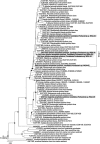Single-cell genomics reveals complex carbohydrate degradation patterns in poribacterial symbionts of marine sponges
- PMID: 23842652
- PMCID: PMC3834845
- DOI: 10.1038/ismej.2013.111
Single-cell genomics reveals complex carbohydrate degradation patterns in poribacterial symbionts of marine sponges
Abstract
Many marine sponges are hosts to dense and phylogenetically diverse microbial communities that are located in the extracellular matrix of the animal. The candidate phylum Poribacteria is a predominant member of the sponge microbiome and its representatives are nearly exclusively found in sponges. Here we used single-cell genomics to obtain comprehensive insights into the metabolic potential of individual poribacterial cells representing three distinct phylogenetic groups within Poribacteria. Genome sizes were up to 5.4 Mbp and genome coverage was as high as 98.5%. Common features of the poribacterial genomes indicated that heterotrophy is likely to be of importance for this bacterial candidate phylum. Carbohydrate-active enzyme database screening and further detailed analysis of carbohydrate metabolism suggested the ability to degrade diverse carbohydrate sources likely originating from seawater and from the host itself. The presence of uronic acid degradation pathways as well as several specific sulfatases provides strong support that Poribacteria degrade glycosaminoglycan chains of proteoglycans, which are important components of the sponge host matrix. Dominant glycoside hydrolase families further suggest degradation of other glycoproteins in the host matrix. We therefore propose that Poribacteria are well adapted to an existence in the sponge extracellular matrix. Poribacteria may be viewed as efficient scavengers and recyclers of a particular suite of carbon compounds that are unique to sponges as microbial ecosystems.
Figures




Similar articles
-
Single-cell genomics reveals the lifestyle of Poribacteria, a candidate phylum symbiotically associated with marine sponges.ISME J. 2011 Jan;5(1):61-70. doi: 10.1038/ismej.2010.95. Epub 2010 Jul 8. ISME J. 2011. PMID: 20613790 Free PMC article.
-
Coexistence of poribacterial phylotypes among geographically widespread and phylogenetically divergent sponge hosts.Environ Microbiol Rep. 2018 Feb;10(1):80-91. doi: 10.1111/1758-2229.12609. Epub 2017 Dec 14. Environ Microbiol Rep. 2018. PMID: 29194987
-
Comparative Genomics Provides Insight into the Function of Broad-Host Range Sponge Symbionts.mBio. 2021 Oct 26;12(5):e0157721. doi: 10.1128/mBio.01577-21. Epub 2021 Sep 14. mBio. 2021. PMID: 34519538 Free PMC article.
-
Marine sponges and their microbial symbionts: love and other relationships.Environ Microbiol. 2012 Feb;14(2):335-46. doi: 10.1111/j.1462-2920.2011.02460.x. Epub 2011 Mar 28. Environ Microbiol. 2012. PMID: 21443739 Review.
-
An environmental genomics perspective on the diversity and function of marine sponge-associated microbiota.Curr Opin Microbiol. 2007 Jun;10(3):215-20. doi: 10.1016/j.mib.2007.05.012. Epub 2007 Jun 15. Curr Opin Microbiol. 2007. PMID: 17574904 Review.
Cited by
-
Symbiotic adaptation drives genome streamlining of the cyanobacterial sponge symbiont "Candidatus Synechococcus spongiarum".mBio. 2014 Apr 1;5(2):e00079-14. doi: 10.1128/mBio.00079-14. mBio. 2014. PMID: 24692632 Free PMC article.
-
The candidate phylum Poribacteria by single-cell genomics: new insights into phylogeny, cell-compartmentation, eukaryote-like repeat proteins, and other genomic features.PLoS One. 2014 Jan 31;9(1):e87353. doi: 10.1371/journal.pone.0087353. eCollection 2014. PLoS One. 2014. PMID: 24498082 Free PMC article.
-
Characterization of ecologically diverse viruses infecting co-occurring strains of cosmopolitan hyperhalophilic Bacteroidetes.ISME J. 2018 Feb;12(2):424-437. doi: 10.1038/ismej.2017.175. Epub 2017 Nov 3. ISME J. 2018. PMID: 29099492 Free PMC article.
-
A genomic view of the microbiome of coral reef demosponges.ISME J. 2021 Jun;15(6):1641-1654. doi: 10.1038/s41396-020-00876-9. Epub 2021 Jan 19. ISME J. 2021. PMID: 33469166 Free PMC article.
-
Taxon-Specific Shifts in Bacterial and Archaeal Transcription of Dissolved Organic Matter Cycling Genes in a Stratified Fjord.mSystems. 2021 Dec 21;6(6):e0057521. doi: 10.1128/mSystems.00575-21. Epub 2021 Dec 14. mSystems. 2021. PMID: 34904860 Free PMC article.
References
-
- Bond C. Continuous cell movements rearrange anatomical structures in intact sponges. J Exp Zool. 1992;263:284–302. - PubMed
-
- De Goeij JM, Moodley L, Houtekamer M, Carballeira NM, Van Duyl FC. Tracing 13C-enriched dissolved and particulate organic carbon in the bacteria-containing coral reef sponge Halisarca caerulea: evidence for DOM feeding. Limnol Oceanogr. 2008;53:1376–1386.
Publication types
MeSH terms
LinkOut - more resources
Full Text Sources
Other Literature Sources
Molecular Biology Databases
Miscellaneous

